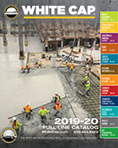3 Steps Toward a COVID-Free Jobsite
READ IN SPANISH
3 Steps Toward a COVID-Free Jobsite
Jobsite COVID-19 mitigation efforts have significantly affected contractor jobsite activities. We all want construction activity to return to pre-pandemic levels, but as areas of our country have been opening up, a sharp spike in COVID-19 cases has come with it. Reported cases in June for many areas have risen higher than our worst numbers in April. With concerns regarding infection still on everyone’s mind, we need to remain diligent and reassess containment procedures and their effects.
Scientists have learned a great deal about the COVID-19 virus in the last six months. Thus OSHA updates their advice to contractors practically on a weekly basis. But one OSHA tenet remains consistent. OSHA expects that “Employers should have a plan for protecting workers and preventing further spread of disease, as well as maintaining the employer’s day-to-day functions.”
Initial jobsite containment requirements were inconsistent and costly
When the virus hit communities, health officials forced wide-ranging measures onto contractors. These restrictions greatly reduced productivity. For example, electrical contractors reported virus-spread containment procedures reduced their productivity by nearly 20%, according to an ELECTRI International report.
Using a rule of thumb estimate for self-performing contractors, researchers predict that a 10% impact on productivity has a 10-fold effect on profitability, not including any of the social and health losses that impact a company’s workforce.
These new insights about COVID-19 have helped focus containment. Health experts, including Bruce Donato, of K&A First Aid and Safety, Inc, urge contractors to adopt enhanced COVID-19 prevention procedures.
The top 3 things you can do on your jobsites to reduce the risk of COVID-19 transmission include: upgrading housekeeping efforts, embracing disinfecting procedures, and reducing worker stress.
1. Upgrading Housekeeping
Donato says that sanitation on jobsites must be more stringent. Elminating virus spread starts with increasing the availability of handwashing and better hygiene in common worker areas.
Workers must have access to soap, clean running water, and single use towels for drying hands.
“Depending on the size or configuration of the jobsite, contractors may need to supply multiple handwashing stations to maintain social distancing,”
Bruce Donato, K&A First Aid and Safety, Inc
Stations should be equipped with foot-activated or touchless trash receptacles and faucets to eliminate touchpoints. Contractors must establish procedures that restock areas during shifts.
For more remote settings, contractors can opt for more portable handwashing stations. These units are comprised of free-standing water storage tanks, soap dispensers and paper towel holders. If this method is used, the water tank should be regularly cleaned and disinfected. Care should be taken with respect to water disposal.
If soap and water are not readily available, Donato suggests that contractors provide alcohol-based hand sanitizers at stations around the job. These stations should be positioned at common touch point areas such as work elevators, tool cribs, and work platforms, to encourage hand hygiene. The sanitizing gel should contain at least 60% alcohol.
2. Inactivating The Virus: Sanitizing vs. Disinfecting
Improved housekeeping efforts focused on cleaning and sanitizing will effectively kill 99.9% of bacteria. But these efforts do not neutralize viruses found on surfaces. Donato urges contractors to identify areas where workers may have the greatest exposure to virus contamination and to institute disinfecting procedures. Proper disinfecting procedures will disarm the COVID-19 virus.
Sanitizing and Disinfecting – Managing COVID-19 in the Workplace
Safety expert Bruce Donato (K&A First Aid & Safety) discusses the practical aspects of managing COVID-19 in the workplace. White Cap Coronavirus Updates: htt…
Jobsite locations that commonly require disinfecting high traffic areas including employee elevators, restrooms, and handrails. Special attention should be given to interior areas with limited air movement. For these larger areas, contractors could consider a wide-range of sprayers and disinfecting agents that can effectively cover surfaces. It is also important to verify that the disinfecting agent conforms to EPA standards. (See EPAs List-N)
Disinfecting is important for larger moveable equipment such as trucks, backhoes, and dozers. Donato says disinfecting should be applied to inside equipment cabs and exterior equipment touchpoints with each operator change.
Disinfecting procedures should also be used on tools and equipment prior to exchanging with others and following each use. Care should be given in selecting disinfecting solutions. Be sure to follow manufacturer recommendations to select agents that aren’t corrosive.
For small touch point areas, Donato suggests using spray bottles that contain bleach diluted with water (1 to 50, respectively). Workers should spray the solution, wait at least 1 minute, then wipe down the areas.
3. Monitoring Employee Response
Effective prevention procedures go beyond just the jobsite and equipment. The COVID-19 virus has increased worker anxiety. Managers should review their new job safety health procedures and eliminate any undue stress. NIOSH identifies several pandemic-induced stress factors for workers including: adapting to different schedules, workloads, new assignments, learning new procedures, and accepting concerns about potential virus exposures.
An effective review can eliminate stresses, that in turn will enable greater participation in preventing the virus on jobsites.
The CDC and NIOSH have recognized how these issues can affect workers and have created a resource that provides ways to combat this stress.
How to Relieve Stress When Returning to Work and Your Daily Commute
Preparing for the Commute Post-Lockdown | Bankrate
Covid-19 affected many aspects of what we considered “normal,” including drivers re-evaluating car insurance needs and increased sanitation guidelines for all industries that rely on transportation, ever-growing vaccine availability is likely to shift activities again. What might driving look like as we shift back to pre-pandemic driving normalcy?
Become a Place of Safe Harbor
OSHA recognizes that construction site exposure to the COVID-19 virus is dependent on the overall infection rate of the community in which it is located. But with a proactive plan that is focused on increasing housekeeping, eliminating contact exposure to the virus, and reducing worker stress, jobsites can become examples of how to eliminate virus spread.




